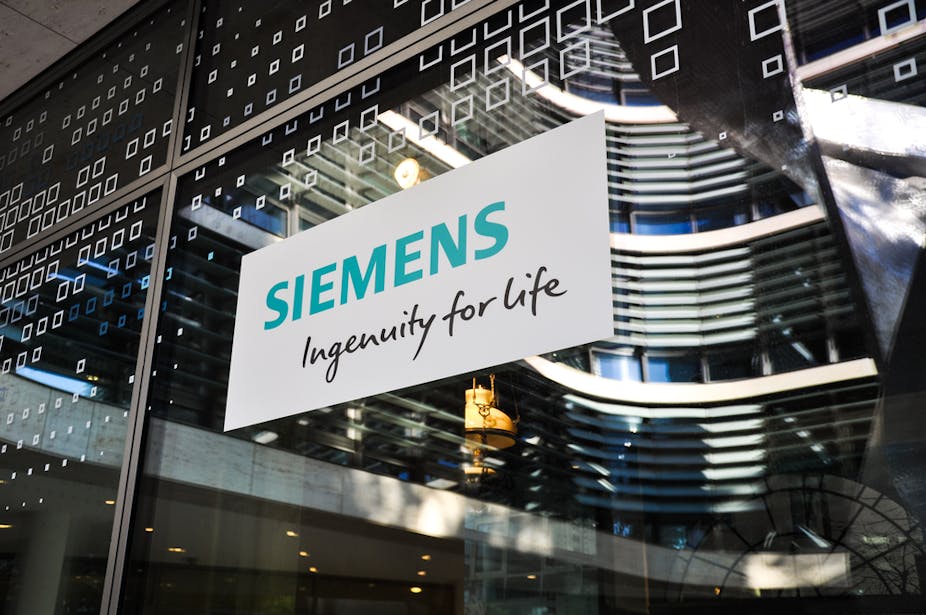Ten years ago a colossal corruption scandal involving Siemens, one of the world’s largest electrical engineering companies, shocked the world. The scale of it marked it out as the biggest corruption case of the time.
A few years later, Linda Thomsen, Director at the Security Exchange Commission described the pattern of bribery in the company as:
… unprecedented in scale and geographic reach. The corruption involved more than $1.4 billion in bribes to government officials in Asia, Africa, Europe, the Middle East and the Americas.
How did it happen and why is it important to keep this case in mind?
Prior to the corruption scandal, the reputation of Siemens was extremely good. It was renowned for its technological products and reliable services in telecommunications, power, transportation and medical equipment. It was common to see articles featuring its activities in remote areas, developing new high quality products and winning competitive bids.
So the world was taken by surprise when the police raided the company headquarters in Munich as well as other subsidiaries on November 15th 2006. The company’s first reaction was to claim innocence and to blame events on a small “criminal gang” .
For years the company had pretended to do business according to the highest ethical and legal standards. Since at least 1991, Siemens had developed corporate anti-corruption norms, fancy codes of conduct and strict business guidelines. It was even selected to become a corporate member of Transparency International’s German chapter in 1998 – a non-governmental organisation created to fight corruption.
The reality was completely different.
Since at least the 1990s, Siemens had organised a global system of corruption to gain market share and increase its price. It was able to get away with this because of big loopholes in the legal systems of a host of countries, including Germany.
Anti-corruption existed only on paper
Over many decades bribes became the accepted business norm at Siemens. They were channelled through hidden bank accounts, obscure intermediaries and pseudo “consultants”. When calculating the cost of a project, Siemens employees used “nützliche aufwendungen”, a common tax term literally translated as “useful expenditures” or internally understood as “bribes.”
The situation wasn’t helped by the fact that the law in Germany was written in a way that allowed bribes to be accounted for as tax-deductible expenses. This changed in 1999 when the country finally brought its law into line with the 1997 OECD Convention on Combating Bribery. This made it illegal to bribe foreign officials for a German company.
On the day the new law was passed in February that year, discussions began at the highest level at Siemens on how to handle the new regulation.
Time for justice
On July 5th 2000, Siemens issued a new corporate circular requiring operating groups and regional companies to ensure that a new anti-corruption clause would be included in all contracts with agents, consultants, brokers, or other third parties. The following year it issued new guidelines that stipulated:
No employee may directly or indirectly offer or grant unjustified advantages to others in connection with business dealings, neither in monetary form nor as some other advantage.
And on taking up a listing on the New York Stock Exchange in 2001, the company became subject to the 1977 Foreign Corruption Practice Act. In addition, from November 2003 the company was obliged to comply with the Sarbanes-Oxley Act, with a code of ethics that required chief financial officers and business heads to act responsibly and with integrity.
In July 2004 Siemens’ chief financial officer delivered a speech entitled “Tone from the Top”. The aim was to show that fighting corruption was finally a priority and contrary to the company’s principles of integrity.
In reality, as a German prosecutor was to comment later, the Siemens compliance programme existed only on paper.
Government investigations into corruption had been launched in Israel, Hungary, Azerbaijan, Taiwan and China while issues were also becoming apparent in Nigeria, Italy, Greece and Liechtenstein.
But, as American prosecutors discovered:
Siemens management failed to adequately investigate or follow up on any of these issues.
All over the word – from Bangladesh, Vietnam, Russia, and Mexico to Greece, Norway Iraq and Nigeria – Siemens paid bribes to government officials and civil servants. The magnitude of the bribery system was widespread. As Reinhard Siekaczek, a Siemens employee put it:
We all knew that what we were doing was illegal. Paying a bribe was customary in practically all business units at Siemens AG, except for business units that deals with lamps and such.
Action was finally taken against Siemens in a number of countries including the US, Germany, Italy and Lichtenstein.
Following the US and German prosecutions, Siemens paid more than $1.6 billion in fines, penalties and disgorgement of profits, including $800 million to US authorities. This was the largest monetary sanction ever imposed in a case under America’s Foreign Corruption Practice Act since it was passed in 1977.
Lessons from a corruption scandal
The Siemens case is emblematic of the past and we hope that it’s remembered and used to set up real compliance programmes. Without real counter actions, the risk is that the spread of corruption will continue as a virus, with companies imitating one other..
Another lesson is that the only real justice system taking on corruption seriously is the US. Only the US Department of Justice has been able to sanction corporations sufficiently. But the US shouldn’t be alone in punishing corporate misconduct. All governments should stop simply saying that corruption is bad. They should also show that it will be punished.

